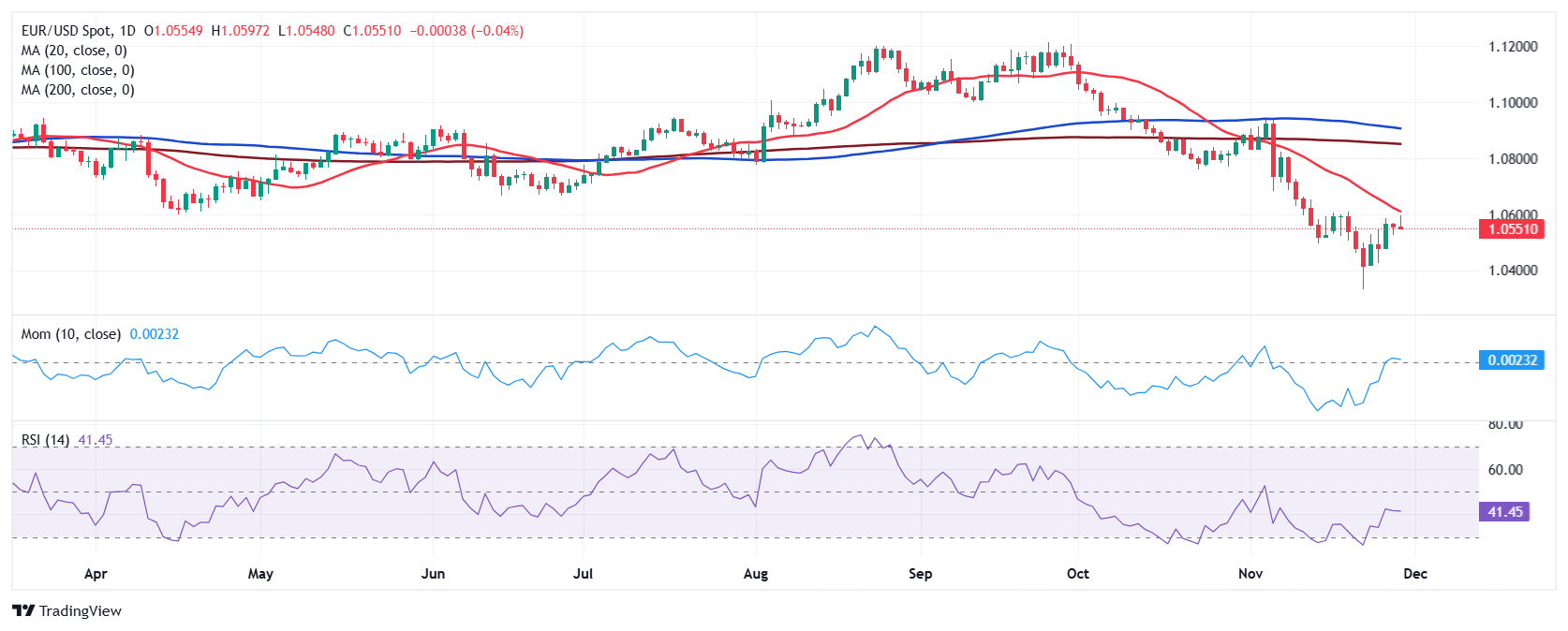- United States employment-related data takes centre stage ahead of the NFP release.
- Inflation data in the Eurozone was a breath of fresh air in anotherwise concerning scenario.
- EUR/USD surged towards 1.0600, but selling interest still leads.
The EUR/USD pair ended a three-week losing streak, recovering towards 1.0600 before finally finding sellers. The US Dollar (USD) gapped lower at the weekly opening after reaching fresh 2024 highs against its European rival, with EUR/USD bottoming at 1.0332 on November 22.
Trump, tariffs and inflation
The week started with headlines indicating that United States (US) president-elect Donald Trump picked billionaire Scott Bessent to serve as the next secretary of the Department of the Treasury. “Unlike in past Administrations, we will ensure that no Americans will be left behind in the next and Greatest Economic Boom, and Scott will lead that effort for me and the Great People of the United States of America,” Trump noted.
Bessent resulted in a breath of fresh air, as in a recent interview he supported a more gradual approach to tariffs. Nevertheless, Trump brought back concerns to the table mid-week, as he threatened to impose a 25% tariff on Mexican and Canadian goods and services and up to 60% on Chinese imports.
Tariffs pose a threat to inflation in times when the Federal Reserve (Fed) is close to claiming victory on price pressures and decided to shift its tightening monetary policy cycle into an easing one.
Meanwhile, investors welcomed headlines indicating a 60-day cease-fire agreement between Israel and Hezbollah. Israel Prime Minister Benjamin Netanyahu declared that the country's government will consider the agreement previously approved by the Israeli military cabinet. Netanyahu, however, added any attempts by Hezbollah to rearm would be considered a violation of the treaty, in which case Israel would respond.
European Central Bank concerned about growth
Across the pond, a more hawkish stance from European Central Bank (ECB) Executive Board member Isabel Schnabel underpinned the Euro in the near term. Schnabel said the ECB is getting closer to neutral territory, estimating the neutral rate at 2% to 3%. Furthermore, she warned about growth risks related to fresh US tariffs under Trump’s administration, urging her colleagues to take a gradual interest rate cut path.
Also, the central bank released the annual Financial Stability Review report, which noted that the Eurozone could face a debt crisis if it did not boost growth, lower public debt and fix policy uncertainty.
Other than that, European inflation data was pretty encouraging. Germany reported that the Harmonized Index of Consumer Prices (HICP) rose 2.4% in the year to November, below the 2.6% anticipated and according to preliminary estimates. The monthly figure came in at -0.7%, much lower than the 0.4% posted in October. The Eurozone HICP rose 2.3% year-over-year (YoY) and slid 0.3% in the month. Finally, the core HICP rose 2.8% YoY in November, slightly higher than the 2.7% increase from October, albeit in line with the market’s forecast.
It is worth adding that Consumer Confidence in the EU deteriorated to -13.7 in November from -12.4 in the previous month, albeit the Economic Sentiment Indicator improved to 95.8 in the same month from 95.7 previously.
The US published on Wednesday the second estimate of the Q3 Gross Domestic Product (GDP), which was confirmed at 2.8% as previously calculated . Initial Jobless Claims for the week ended November 22 improved to 213K from the previous 215K, also beating expectations of 217K.
Durable Goods Orders, in the meantime, rose a modest 0.2% in October, worse than the 0.5% advance anticipated but better than the -0.4% posted in September. Finally, the October Personal Consumption Expenditures (PCE) Price Index rose 0.2% MoM and 2.3% YoY as expected. The core annual figure increased by 2.8% YoY, also meeting the market’s forecast.
Financial markets went into hibernation on Thursday, as US markets closed amid the Thanksgiving holiday, which also meant an early close on Friday.
US employment under scrutiny
The upcoming week will bring multiple relevant macroeconomic figures, starting on Monday with the US November ISM Manufacturing Purchasing Manager Index (PMI) and the S&P Global Manufacturing PMIs from both economies. The S&P Services and Composite PMIs will be out on Wednesday when the EU releases the October Producer Price Index (PPI) and the US will publish the November ADP Employment Change report and the official ISM Services PMI for the same month.
The Eurozone will publish Retail Sales on Thursday, while the week will end with the release of the US Nonfarm Payrolls report and the preliminary estimate of the December Michigan Consumer Sentiment Index.
US employment figures will gather most of the attention, as a tight labor market was among the main reasons inflation took so long to recede. On the one hand, the Fed seeks to keep unemployment under control, yet on the other, it needs to address the weakness in the sector to tackle price pressures.

EUR/USD technical outlook
The EUR/USD pair hovers around 1.0550 and the weekly chart shows it posted a higher low yet held below the previous weekly top at 1.0609, suggesting unconvinced buyers. The same chart shows technical indicators are bouncing just modestly from oversold readings, lacking enough upward strength to support another leg north. Finally, the pair keeps developing below all its moving averages, with the 20 Simple Moving Average (SMA) gaining downward traction between the 100 and 200 SMAs. All in one, it seems profit-taking helped EUR/USD these last few days, yet the bearish risk remains in place.
According to the daily chart, the EUR/USD corrective advance may well be over. The Momentum indicator keeps heading higher, although below its midline, while the Relative Strength Index (RSI) indicator has lost directional strength and turned flat at around 41. Even further, the intraday peak was set just below a firmly bearish 20 SMA, which keeps sliding below marginally bearish 100 and 200 SMAs.
A slide below the 1.0500 threshold will open the door for another leg south. The next support level comes at 1.0440, the October 2023 low, en route to 1.0400. A break below the latter should be followed by a retest of the year low in the 1.0330 price zone.
Beyond the 1.0610 price zone, EUR/USD could extend its corrective advance towards 1.0700 without hurting the long-term bearish perspective. Gains beyond the latter, however, will likely spook sellers and encourage buyers, pushing the pair towards the 1.0780/1.0800 region.

Economic Indicator
Nonfarm Payrolls
The Nonfarm Payrolls release presents the number of new jobs created in the US during the previous month in all non-agricultural businesses; it is released by the US Bureau of Labor Statistics (BLS). The monthly changes in payrolls can be extremely volatile. The number is also subject to strong reviews, which can also trigger volatility in the Forex board. Generally speaking, a high reading is seen as bullish for the US Dollar (USD), while a low reading is seen as bearish, although previous months' reviews and the Unemployment Rate are as relevant as the headline figure. The market's reaction, therefore, depends on how the market assesses all the data contained in the BLS report as a whole.
Read more.Next release: Fri Dec 06, 2024 13:30
Frequency: Monthly
Consensus: 183K
Previous: 12K
Source: US Bureau of Labor Statistics
America’s monthly jobs report is considered the most important economic indicator for forex traders. Released on the first Friday following the reported month, the change in the number of positions is closely correlated with the overall performance of the economy and is monitored by policymakers. Full employment is one of the Federal Reserve’s mandates and it considers developments in the labor market when setting its policies, thus impacting currencies. Despite several leading indicators shaping estimates, Nonfarm Payrolls tend to surprise markets and trigger substantial volatility. Actual figures beating the consensus tend to be USD bullish.
Information on these pages contains forward-looking statements that involve risks and uncertainties. Markets and instruments profiled on this page are for informational purposes only and should not in any way come across as a recommendation to buy or sell in these assets. You should do your own thorough research before making any investment decisions. FXStreet does not in any way guarantee that this information is free from mistakes, errors, or material misstatements. It also does not guarantee that this information is of a timely nature. Investing in Open Markets involves a great deal of risk, including the loss of all or a portion of your investment, as well as emotional distress. All risks, losses and costs associated with investing, including total loss of principal, are your responsibility. The views and opinions expressed in this article are those of the authors and do not necessarily reflect the official policy or position of FXStreet nor its advertisers. The author will not be held responsible for information that is found at the end of links posted on this page.
If not otherwise explicitly mentioned in the body of the article, at the time of writing, the author has no position in any stock mentioned in this article and no business relationship with any company mentioned. The author has not received compensation for writing this article, other than from FXStreet.
FXStreet and the author do not provide personalized recommendations. The author makes no representations as to the accuracy, completeness, or suitability of this information. FXStreet and the author will not be liable for any errors, omissions or any losses, injuries or damages arising from this information and its display or use. Errors and omissions excepted.
The author and FXStreet are not registered investment advisors and nothing in this article is intended to be investment advice.
Recommended Content
Editors’ Picks

EUR/USD clings to daily gains near 1.0300 after US PMI data
EUR/USD trades in positive territory at around 1.0300 on Friday. The pair breathes a sigh of relief as the US Dollar rally stalls, even as markets stay cautious amid geopolitical risks and Trump's tariff plans. US ISM PMI improved to 49.3 in December, beating expectations.

GBP/USD holds around 1.2400 as the mood improves
GBP/USD preserves its recovery momentum and trades around 1.2400 in the American session on Friday. A broad pullback in the US Dollar allows the pair to find some respite after losing over 1% on Thursday. A better mood limits US Dollar gains.

Gold retreats below $2,650 in quiet end to the week
Gold shed some ground on Friday after rising more than 1% on Thursday. The benchmark 10-year US Treasury bond yield trimmed pre-opening losses and stands at around 4.57%, undermining demand for the bright metal. Market players await next week's first-tier data.

Stellar bulls aim for double-digit rally ahead
Stellar extends its gains, trading above $0.45 on Friday after rallying more than 32% this week. On-chain data indicates further rally as XLM’s Open Interest and Total Value Locked rise. Additionally, the technical outlook suggests a rally continuation projection of further 40% gains.

Week ahead – US NFP to test the markets, Eurozone CPI data also in focus
King Dollar flexes its muscles ahead of Friday’s NFP. Eurozone flash CPI numbers awaited as euro bleeds. Canada’s jobs data to impact bets of a January BoC cut. Australia’s CPI and Japan’s wages also on tap.

Best Forex Brokers with Low Spreads
VERIFIED Low spreads are crucial for reducing trading costs. Explore top Forex brokers offering competitive spreads and high leverage. Compare options for EUR/USD, GBP/USD, USD/JPY, and Gold.